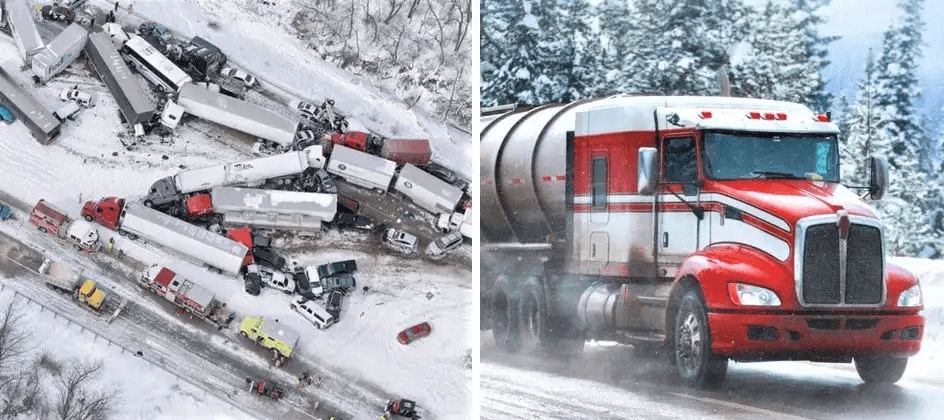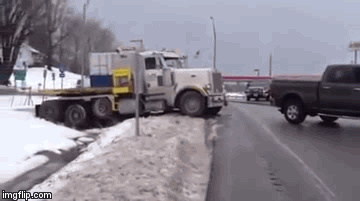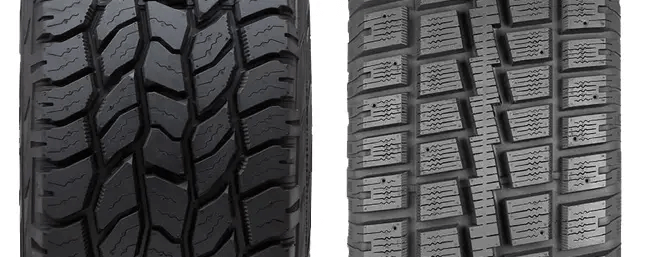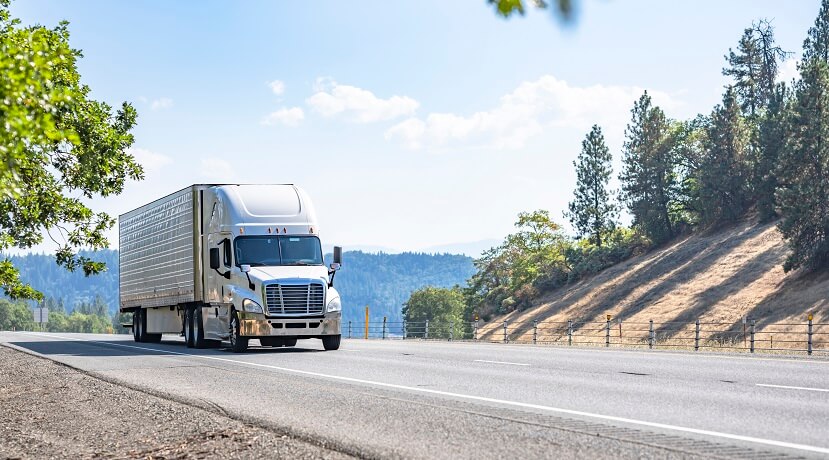
The SIX Winter Tire Tips To Keep You Alive and Safe This Season

Winter driving can be a real pain in the rear-view-mirror…
but you’ve got loads to deliver. And come ice or snow, it’s your tires that keep you on the go! Give your tires extra love this winter with these must-know tire tips:
1. Thread Depth
Checking your thread depth should be a part of routine maintenance year-round but it’s particularly important when snow and ice are present.
Maintain Traction
Tire Rack suggests, “If rain and wet roads are a concern, you should consider replacing your tires when they reach approximately 4/32″ of remaining tread depth.” Additionally, if snow-covered roads are a concern, you should consider replacing your tires when they reach approximately 5/32″ of remaining tread depth to maintain good traction and mobility.
Avoid Citations
New tires start out with 10/32” of tread depth. Per the Department of Transportation (DOT), the minimum tread depth for steer tires is 4/32-inch on every major tread groove, and 2/32-inch for any other wheel position. If even one spot on one major groove is less than required, the driver can be issued a citation. Note: The thin decoupling groove at the shoulder is not considered a major groove.
2. Tire Pressure
As people, we don’t like feeling like we’re under a lot of pressure…but that could be different for your tires. Tire pressure checks should be done frequently in winter months. Proper inflation extends the life of your tires and saves on fuel mileage. Cha-ching!

Things to consider:
- If trailers are empty or full
- Typical (or average) size of loads your fleet carries
- Light vs. heavy loads
- Balanced or unbalanced trailer weight
- Weather forecast for your routes
There’s still some debate in the trucking industry around ideal psi for the above mentioned. It ranges somewhere between 75 – 105 psi. One opinion, by Truckinginfo.com, suggests, “The idea is to keep your inflation pressures in line with your tire loads, always inflate the tires to carry the maximum load, even if you load light some of the time.”
For more recommendations on psi for both drive and trailer tires, check out The Magic Number by Jim Park. Also, share your tire pressure tips with us on Facebook & LinkedIn.
Remember: Tire pressure is not arbitrary. Each tire manufacturer establishes a range (with minimum and maximum psi) for drivers. Staying within these guidelines is crucial to safety.
3. Chains & Gains
It’s important to remember that chains are designed for increased safety but are NEVER a substitute for speed and following distance. In other words, still maintain slower speeds and greater distance from other vehicles when snowy/icy conditions are present.
DIY Chains
Know how to put your chains on. Don’t wait until you’re out in a blizzard on the side of the road with no cell signal to try it for the first time. Follow along with the video below and become an expert in minutes:
4. Groovey
When driving with snow on the roadway, keep your tires in the grooves created by other vehicles in the street. Don’t try to be a hero and pave the way for others. Staying in these grooves on unplowed roads helps you gain and maintain traction … Veering into the snow when unnecessary can pull you off the road. Hello, ditch! And hello major inconvenience…

More Tips
For more winter truck driving tips take a ride with Youtuber, 1776Filmz, for a first-person perspective.
5. A Reminder of Frequency
Check your tires OFTEN.

Freezing temperatures can cause slippery driving conditions (obviously). So, it should also be obvious how important frequent tire checks are during winter months. Even a quick check while you’re refueling can make all the difference. The condition of your tires WILL help prevent breakdowns and accidents.
6. Winter Tires vs. All-Season Tires:
Fleet Owners
Many fleet owners are faced with the decision whether to invest in additional sets of winter tires or not. This decision is often based on snowfall and how severe winter is on their routes. Fleet owners should consider that ice braking is typically better with winter tires. Depending on the brand, they could help your drivers stop much faster than with all-season tires.
Studs
Many winter tires have pen-tip sized holes that can be plugged with studs to contribute next-level traction, especially in icy conditions. Note: Studs are not legal in all states.
Click here for a full list of studded tire regulations broken down per state/province.
This photo shows an all-season tire (left) and a winter tire (right) side by side. Notice the major differences?

First, the winter tire has small holes to insert studs if needed. Additionally, the all-terrain tire has some siping (thin slits), but there is far more all over the winter tire (even down the central rib). These thin slits open up and close as the tire rotates and helps keep the tire in contact with the roadway.
Compounds
Arguably, the most important design distinction between all-terrain “all-season” tires and true winter tires is something you can’t actually see…the tire tread compounds are fundamentally different. The reason, once again, is design purpose and intended use.
Winter tire compounds are designed specifically to function in temperatures near or below freezing. In these temperatures the tire compound remains pliable, which is critical to proper interaction with the road surface. By contrast, dedicated summer tires drastically harden in freezing temperatures, which prohibits road surface interaction. All-terrain “all-season” tires remain more pliable in cold temperatures vs. summer tires, but the pliability of winter tires in freezing temperatures is on a whole other level.
You still with us? Okay…in conclusion, all-terrain “all-season” tires offer many great advantages, but drivers shouldn’t confuse these tires with true winter tires. The adage “choose the right tool for the job” still applies here. To achieve uncompromised winter traction in all varieties of wintertime road conditions, a full-fledged winter tire remains a necessity.
You made it through all six points! Here’s a funny gif of a truck sliding down a hill to reward you:

BONUS TIP:
Tire Spray
This is one of the most important (and commonly forgotten) winter driving tips. A good way to assess the road condition is to observe the amount of water coming off the tires of vehicles around you. Lots of water obviously indicates it’s wet, but (keep in mind) If the tire spray is relatively less, this means the roadway has likely started to freeze.
For more winter driving tips, tools and tricks have a look through our trucking blog and also peep our Winter Survival List for truckers.



